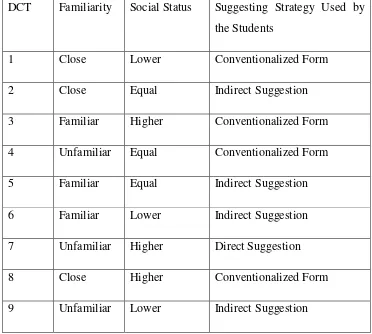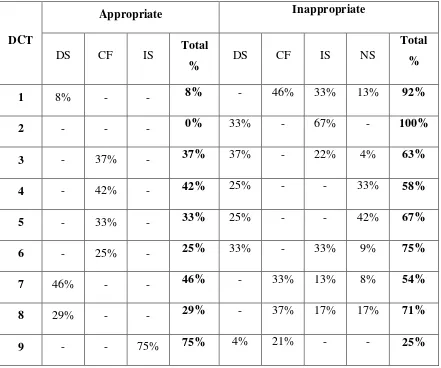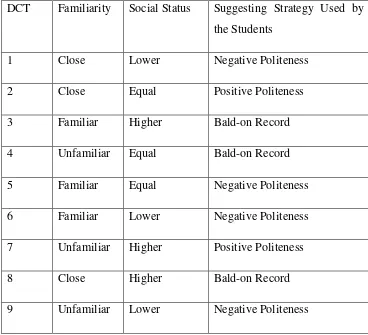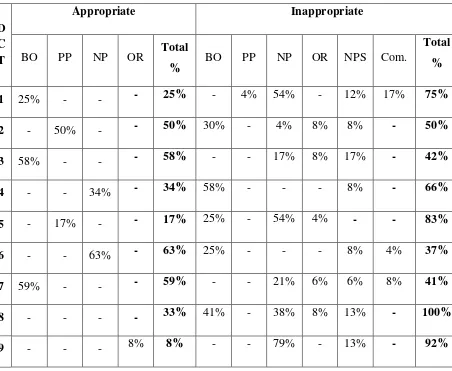POLITENESS STRATEGIES OF SUGGESTING UTTERANCES BY THE FIRST SEMESTER STUDENTS OF ENGLISH DEPARTMENT OF
MUHAMMADIYAH UNIVERSITY OF SURAKARTA
PUBLICATION ARTICLE
Submitted as a Partial Fulfilment of the Requirements for Getting Bachelor Degree of Education
in English Department
By
SONIA FITRI ASTUTI A320130113
SCHOOL OF TEACHER TRAINING AND EDUCATION MUHAMMADIYAH UNIVERSITY OF SURAKARTA
POLITENESS STRATEGIES OF SUGGESTING UTTERANCES BY THE FIRST SEMESTER STUDENTS OF ENGLISH DEPARTMENT OF
MUHAMMADIYAH UNIVERSITY OF SURAKARTA Sonia Fitri Astuti, Dra. Siti Zuhriah Ariatmi, M.Hum
Department of English Education University of Muhammadiyah Surakarta
Jl. Ahamad Yani Tromol Pos 1 Pabelan, Kartasura, Surakarta (57127) e-mail: [email protected]
ABSTRACT
This research aims at describing the strategies of suggesting and the realization of politeness strategy of suggesting strategies used by the first semester students of English Department of Muhammadiyah University of Surakarta. The data used in this research are utterances which are used by the first semester students. The researcher use Discourse Completion Task (DCT) to collect the data. The techniques of analyzing data are making the DCT scenario, documenting the data, analyzing the findings and drawing conclusion. The data are analyzed by using the theory of suggesting strategy (Flor, 2005) and theory of politeness (Brown and Levinson, 1987). The researcher found that: (1) there are three types of suggesting strategies used by the students namely; direct suggestion takes 15%, conventionalized form takes 34%, indirect suggestion takes 1%. The utterances which do not belong to suggesting strategy take 50%. There are 22% of the students who use the suggesting strategy appropriately, and 78% of the students use suggesting strategy inappropriately because they fail to choose the appropriate suggesting strategy in relation with the power property of the speakers, the distance among the speakers and the seriousness of the case that makes them are over polite and impolite, (2) there are four types of politeness strategies used by the students namely: bald-on record takes 30%, positive politeness takes 36%, negative politeness takes 23%, bald off record takes 3%. The utterances which do not belong to politeness strategy take 9%. There are 36% of the students who use politeness strategy appropriately and 64% of the students use politeness strategy inappropriately because they fail to choose the appropriate politeness strategy in relation with the power property of the speaker, the distance among the speakers and the seriousness of the case.
POLITENESS STRATEGIES OF SUGGESTING UTTERANCES BY THE FIRST SEMESTER STUDENTS OF ENGLISH DEPARTMENT OF
MUHAMMADIYAH UNIVERSITY OF SURAKARTA Sonia Fitri Astuti, Dra. Siti Zuhriah Ariatmi, M.Hum
Department of English Education University of Muhammadiyah Surakarta
Jl. Ahamad Yani Tromol Pos 1 Pabelan, Kartasura, Surakarta (57127) e-mail: [email protected]
ABSTRAK
Penelitian ini bertujuan untuk mendeskripsikan strategi dalam memberikan saran dan penggunaan kesantunan yang digunakan oleh mahasiswa semester satu jurusan pendidikan bahasa Inggris Universitas Muhammadiyah Surakarta. Data yang digunakan dalam penelitian ini adalah ujaran-ujaran yang digunakan mahasiswa semester satu. Peneliti menggunakan Discourse Completion Task (DCT) untuk mengumpulkan data. Teknik yang digunakan untuk menganalisis data adalah membuat naskah DCT, mendokumentasikan data, menganalisis data temuan dan menarik kesimpulan. Data dianalisis menggunakan teori memberikan saran (Flor, 2005) dan teori kesantunan (Brown and Levinson, 1987). Peneliti menemukan bahwa: (1) terdapat tiga tipe strategi dalam memberikan saran; direct suggestion (15%), conventionalized form (34%), indirect suggestion (1%). Ujaran yang tidak termasuk dalam straegi memberi saran ada 50%. 22% mahasiswa menggunakan strategi memberi saran dengan tepat dan 78% mahasiswa tidak menggunakan strategi memberi saran dengan tepat karena mahasiswa tersebut gagal dalam memilih strategi yang tepat sesuai dengan kekuasaan yang dimiliki pembicara, hubungan antara pembicara dan pendengar serta kegentingan situasi, sehingga mereka menjadi tidak sopan dan terlalu sopan, (2) terdapat empat tipe strategi kesantunan yang digunakan mahasiswa; bald-on record (30%), positive politeness (36%), negative politeness(23%) dan bald off record (3%). Ujaran yang tidak termasuk dalam strategi kesantunan ada 9%. 36% mahasiswa menggunakan strategi kesantunan dengan tepat, dan 64% mahasiswa tidak menggunakan strategi kesantunan dengan tepat karena mereka gagal dalam memilih strategi kesantunan yang tepat sesuai dengan kekuasaan yang dimiliki pembicara, hubungan antara pembicara dan pendengar serta kegentingan situasi, sehingga mereka menjadi tidak sopan dan terlalu sopan
1. INTRODUCTION
Language act performed by producing utterances is called speech act (Yule, 1996:48). When the speakers say something, they will expect that the hearer will be affected by those utterances. Speech act consists of three related acts, they are; locutionary act, illocutionary act, and perlocutionary act. Yule (1996:53) classified illocutionary act into five acts. They are declaration, representatives, expressives, commisives, and directives. Directives are the kinds of illocutionary act in which the speaker use an utterance to get someone else to do something (Yule, 1996:54).
One of the primary and essential acts of directive is suggesting act. People sometimes give suggestions to the others when they get confused or misbehave. Suggestion is a language act by which one person guides the thoughts, feelings, or behaviours of another. Rintell in Flor (2005:168) states that when the speaker uses suggestion, the speaker asks the hearer to do something that the speaker believes it will benefit the hearer. Suggestion is a common speech act which is frequently used in people’s daily interactions.
Unconsciously, people tend to use words to make suggestions in communication. As English language learners, students of English department have to know how to express utterances in English appropriately. English Department students have different background of languages. Most of them speak in their first languages or their second languages. In this research, the researcher would like to know how English department students, especially first semester students, express their suggestions in foreign language, i.e. English. The researcher chooses first semester students because most of them are not aware of the words they use to give suggestions and how the politeness strategies used to express the suggestions.
not mention politeness in teaching functional conversation, yet the lesson goal is focused on the application and the mastery in using various kinds of utterances. Politeness deserves to be given the emphasis in teaching English especially to the students who lack pragmatic competence, so they will not produce grammatically flawless speech that nonetheless fails to achieve its communicative aims.
One of the most famous and influential theories on politeness is proposed by Brown and Levinson (1987) which is a face-saving view on politeness. According to Brown and Levinson (1987), directive utterance especially suggestion, is considered as intruding into the hearer's world by performing an act that concerns what the hearer should do. It threatens either the hearer’s or the speaker’s face-wants. Face in this manner is the public self-image that every member wants to claim for himself. Politeness strategies are used to minimize the Face Threatening Act (FTA) when the speaker wants to give suggestion to the other people. There are four strategies of politeness; bald on record, positive politeness, negative politeness, and off record (Brown and Levinson, 1987:92).
There are some previous researches which are related to this research. The first researcher, Jayantri (2014) conducted a research which focused on the pragmalinguistic forms used in the suggestion and the differences of strategies suggestions both by fourth semester female and male students of English Department Muhammadiyah University in the speaking class 2011. The research resulted that there are eight kinds of suggestion utterance: direct performative verb, direct noun of suggestion, conventionalized forms possibility/probability, conventionalized forms should, conventionalized forms conditional, indirect impersonal, hints, and certain modals and semi-modals used
taken from the dialogues containing suggestions uttered by both male and female characters. The result of the research showed that: (1) there are three types of suggestions presenting in the data, they are direct suggestion, conventionalized form of suggestion and the last is indirect suggestion, (2) in terms of politeness strategy, the research shows that all of the direct suggestions always employ bald on record, indirect suggestions can never use bald on record strategy, while suggestions in conventionalized form are mostly loaded with bald on record, but can be occasionally loaded with another politeness strategy, such as positive politeness, (3) although gender is not a significant factor, but gender may influence the choice of suggestions and the other factors which influence the choice of suggestions are power, social distance and the size of imposition.
The benefit of this research consists of theoritical benefit and practical benefit. Theoritically, this research is expected to give valuable contribution in linguistics research, especially in the field of pragmatics and politeness on education. Practically, this research is expected to enrich the researcher and the reader’s knowledge, especially English teacher so that they can apply it in teaching learning process to help the students to reach the effective conversation, and give pragmatic awareness views.
2. RESEARCH METHOD
The type of this research is descriptive qualitative research. The object of this research are suggesting strategies and the politeness strategies of suggesting utterances used by the first semester students of Muhammadiyah University of Surakarta.
procedures: (1) analyzing the strategies of suggesting utterances made by the students based on Flor’s theory, (2) analyzing the politeness strategy based on Brown and Levinson’s theory, (3) summarizing the findings into the table, (4) discussing the findings and (4) drawing conclusion.
3. RESEARCH RESULT AND DISCUSSION
In this section, the researcher presents the result of the discussion as follows: 3.1 The Influence of Social Status and Familiarity in Students’
Suggesting Utterances
From the findings and data analysis, the researcher distributes the percentage of suggesting strategies used by the students in the chart below:
Chart 1.1 Percentage of Suggesting Strategies Used By the Students
From chart 1.1 the researcher finds several strategies of suggesting used by the students, namely direct suggestion (DS), conventionalized form of suggestion (CF) and indirect suggestion (IS). The researcher also finds that there are students who do not use strategy of suggestion (NS). It can be seen that 15% of the students use direct suggestion, 34% use conventionalized form of suggestions, 1% use indirect suggestion and 50% of the students do not use any suggestion strategy. 15% of the students prefer to use direct suggestion because they want to give their suggestion directly and to show their closeness with the hearer. 34% of the students prefer to use conventionalized form because they do not want
0% 10% 20% 30% 40% 50% 60%
to sound authoritative. They use mitigating device such as modals, semi-modals, conditionals, recommendations in their suggestion utterances to weaken the force and authority. 1% of the students use indirect suggestion because they want to show some respect towards the hearer, so they want to express their suggestions indirectly. In addition, 50% of the students prefer to use the other sentences to express their suggestion which do not belong to any suggestion strategy.
Moreover, there is correlation between social status and familiarity with suggesting strategies used by the students. The researcher presents it on the table below:
Table 1.1 the Correlation between Social Status and Familiarity with Suggesting
Strategies
DCT Familiarity Social Status Suggesting Strategy Used by the Students
1 Close Lower Conventionalized Form 2 Close Equal Indirect Suggestion
3 Familiar Higher Conventionalized Form
4 Unfamiliar Equal Conventionalized Form
5 Familiar Equal Indirect Suggestion
6 Familiar Lower Indirect Suggestion 7 Unfamiliar Higher Direct Suggestion
8 Close Higher Conventionalized Form
9 Unfamiliar Lower Indirect Suggestion
[image:11.595.145.517.327.661.2]higher status. Meanwhile, the students use indirect suggestion when they are close to the hearer and have equal status, when they are familiar and have equal status, when they are familiar and have lower status, and when they have unfamiliar relationship with the hearer and have lower status. Lastly, the students use direct suggestion when they are unfamiliar with the hearer and have higher status.
[image:12.595.121.562.287.655.2]Furthermore, the researcher distributes the percentage of suggesting strategies and its appropriateness of each DCT scenario on the table below:
Table 1.2 List of Percentage of Suggesting Strategy and the Appropriateness
DCT
Appropriate Inappropriate
DS CF IS Total
% DS CF IS NS
Total %
1 8% - - 8% - 46% 33% 13% 92%
2 - - - 0% 33% - 67% - 100%
3 - 37% - 37% 37% - 22% 4% 63%
4 - 42% - 42% 25% - - 33% 58%
5 - 33% - 33% 25% - - 42% 67%
6 - 25% - 25% 33% - 33% 9% 75%
7 46% - - 46% - 33% 13% 8% 54%
8 29% - - 29% - 37% 17% 17% 71%
9 - - 75% 75% 4% 21% - - 25%
use suggesting strategy inappropriately that makes the suggestion utterances impolite and/or over polite.
In DCT 1, 92% of the students fail to choose the appropriate suggesting strategy in relation with the distance between the speaker and the hearer. In DCT 2, 100% of the students fail to choose the appropriate suggesting strategy in relation with the power property of the speaker and the distance between the speaker and the hearer. In DCT 3, 63% of the students fail to choose the appropriate suggesting strategy in relation with the seriousness of the case and the distance between the speaker and the hearer. In DCT 4, 58% of the students fail to choose the appropriate suggesting strategy in relation with the power property of the speaker and the distance among the speakers. In DCT 5, 67% of the students fail to choose the appropriate suggesting strategy in relation with the distance between the speaker and the hearer. and the seiousness of the case. In DCT 6, 75% of the students fail to choose the appropriate suggesting strategy in relation with the distance between the speaker and the hearer. In DCT 7, 54% of the students fail to choose the appropriate suggesting strategy in relation with the distance among the speakers and the seriousness of the case. In DCT 8, 71% of the students fail to choose the appropriate suggesting strategy in relation with the power property of the speaker and the distance between the speaker and the hearer.
Flor (2005) states that the sub-strategies of direct suggestion are using performative verb and imperative. However, the researcher found that the speaker can use the word “better” as it shows that the speaker express the suggestion by directly utter their intention. The researcher also found that in indirect suggestion, the speaker can use the other structures of sentence other than impersonal sentence as long as it is meant to express the suggestion by indirectly utter the intention.
3.2 The Influence of Social Status and Familiarity on the Politeness
Strategies of Students’ Suggesting Utterances
analysis, the researcher distributes the percentage of the politeness strategy used by the students in the following chart below:
Chart 1.2 Percentage of Politeness Strategy Used by the Students
Based on chart 1.2 the researcher finds four types of politeness strategies used by the students namely: bald on record (BO), positive politeness (PP), negative politeness (NP) and off record (OR). The researcher also finds that there are students who do not use politeness strategy in their utterances. 36% of the students use bald-on record because they want to utter their intention with maximum efficiency by directly addressing the hearer, 9% use positive politeness because they want to minimize the impact of the FTA by using identity marker and exaggerating, 41% use negative politeness because they want to satisfy the hearer’s face and not impose the hearer’s territory by begging for forgiveness or apologizing, being tentative and using questions, and 3% use off record strategy because they want to be indirect and let the hearer interpret their suggestion by using hints. Meanwhile, 9% of students’ utterances do not belong to politeness strategy and 4% of the students use combination of politeness strategy because they want to show their closeness with the hearer by not imposing the hearer’s territory .
Moreover, there is correlation between social status and familiarity with politeness strategies used by the students. The researcher presents it on the table below:
Table 1.3 the Correlation between Social Status and Familiarity with Politeness
Strategies
DCT Familiarity Social Status Suggesting Strategy Used by the Students
1 Close Lower Negative Politeness
2 Close Equal Positive Politeness
3 Familiar Higher Bald-on Record 4 Unfamiliar Equal Bald-on Record
5 Familiar Equal Negative Politeness
6 Familiar Lower Negative Politeness
7 Unfamiliar Higher Positive Politeness
8 Close Higher Bald-on Record 9 Unfamiliar Lower Negative Politeness
Based on table 1.3, the researcher finds that the students use bald-on record in the situation when the speaker is familiar to the hearer and have higher status, when the speaker is unfamiliar to the hearer and have equal status, and when they are close to the hearer and have higher status. Meanwhile, the students use positive politeness in the situation where the speaker is close to the hearer and have equal power, and where the speaker is unfamiliar to the hearer and have higher status. Lastly, the students use negative politeness in the situation where the speaker is close to hearer and have lower status, where the speaker is familiar to the hearer and have lower and equal status, and where the speaker is unfamiliar to the hearer and have lower status.
[image:15.595.146.514.119.454.2]Table 1.4 List of the Percentage of Politeness Strategies and the Appropriateness
D C T
Appropriate Inappropriate
BO PP NP OR Total
% BO PP NP OR NPS Com.
Total %
1 25% - - - 25% - 4% 54% - 12% 17% 75%
2 - 50% - - 50% 30% - 4% 8% 8% - 50%
3 58% - - - 58% - - 17% 8% 17% - 42%
4 - - 34% - 34% 58% - - - 8% - 66%
5 - 17% - - 17% 25% - 54% 4% - - 83%
6 - - 63% - 63% 25% - - - 8% 4% 37%
7 59% - - - 59% - - 21% 6% 6% 8% 41%
8 - - - - 33% 41% - 38% 8% 13% - 100%
9 - - - 8% 8% - - 79% - 13% - 92%
Based on the table 1.4 the researcher finds that there are 38% of the students who use politeness strategy appropriately and 62% use politeness strategy inappropriately that makes the utterances are impolite and/or over polite.
students fail to choose the appropriate politeness strategy in relation with the distance among the speakers. In DCT 8 , 100% of the students fail to choose the appropriate politeness strategy in relation with the distance between the speaker and the hearer. Lastly, 92% of the students in DCT 9 fail to choose the appropriate politeness strategy in relation with the power property of the speaker and the distance between the speaker and the hearer.
4. CLOSING
Based on the analysis of finding and discussion, the researcher draws conclusion that the students do not use suggesting strategy and politeness strategy appropriately because they fail to choose appropriate strategy in relation with the power property of the speaker, the distance among the speaker and the seriousness of the case.
BIBLIOGRAPHY
Brown, Penelope and Stephen C. Levinson. 1987. Politeness: Some Universal in Language Usage. London: Cambridge University press
Flor, Alicia M. 2005. “A Theoretical Review of the Speech Act of Suggesting: Towards a Taxonomy for its Use in FLT”. Journal of Pragmatic. Vol. 18. Accessed on October 12, 2016 (https://rua.ua.es/dspace/bitstream/10045/5216/1/RAEI_18_08.pdf) Jayantri, Kecik. 2014. Pragmatic Analysis on the Suggestion Utterances
Conveyed By the Students of Fourth Semester of English Department of UMS in the Speaking Class. Surakarta: Muhammadiyah University of Surakarta.
Paramita, Ressani E. 2016. Politeness Strategies in Suggestions Employed by
Male and Female Characters in the Novel Entitled “Can You Keep A
Secret?” (Pragmatic Approach). Surakarta: Sebelas Maret University.



